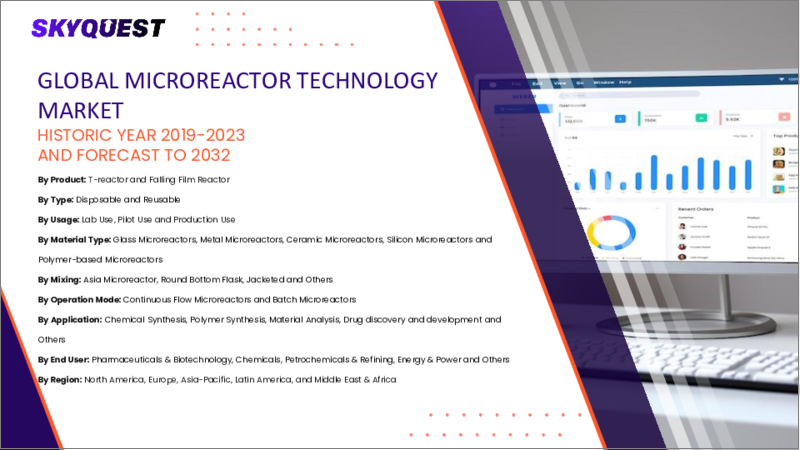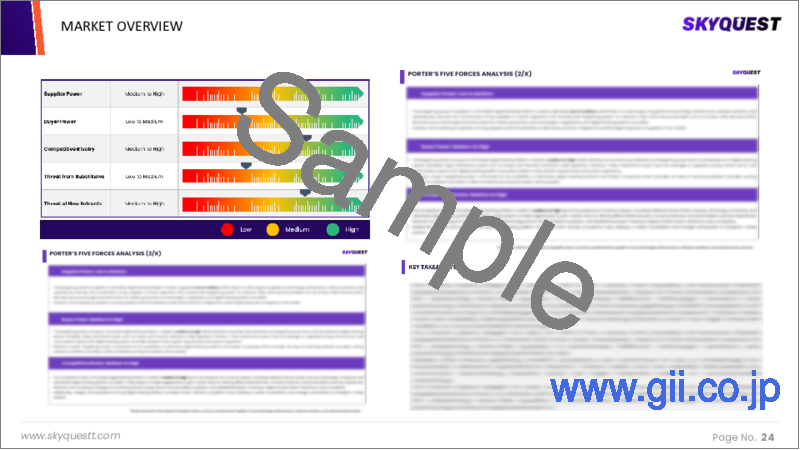|
|
市場調査レポート
商品コード
1647517
マイクロリアクター技術の市場規模、シェア、成長分析:タイプ別、製品タイプ別、ミキシング別、用途別、エンドユーザー別、地域別 - 産業予測 2025~2032年Microreactor Technology Market Size, Share, and Growth Analysis, By Type (Disposable, Reusable), By Product Type (T-reactor, Falling Film Reactor), By Mixing, By Application, By End User, By Region - Industry Forecast 2025-2032 |
||||||
|
|||||||
| マイクロリアクター技術の市場規模、シェア、成長分析:タイプ別、製品タイプ別、ミキシング別、用途別、エンドユーザー別、地域別 - 産業予測 2025~2032年 |
|
出版日: 2025年01月29日
発行: SkyQuest
ページ情報: 英文 157 Pages
納期: 3~5営業日
|
全表示
- 概要
- 目次
マイクロリアクター技術市場規模は、2023年に4億4,320万米ドルと評価され、2024年の5億2,564万米ドルから2032年には20億5,760万米ドルに成長し、予測期間(2025~2032年)のCAGRは18.6%で成長する見通しです。
世界のマイクロリアクター技術市場は、費用対効果の高いソリューションと効率的な設計を提供する3Dプリントマイクロリアクターに対する需要の高まりによって、大きな成長を遂げています。この動向は、様々な産業における規制圧力と安全性への懸念の高まりによってさらに促進されており、特に、技術の進歩と急成長しているナノ医薬品分野が採用拡大の道を開いている医薬品では顕著です。既存の医薬品市場が飽和状態になるにつれて、ナノ薬剤学の機会が生まれ、ファインケミカルや特殊化学メーカーの間でマイクロリアクターの魅力が高まっています。混合操作との卓越した互換性とワンステップ反応を実行する能力は、生産コストを合理化するだけでなく、環境問題にも対処し、最終的には化学産業全体の効率改善と収率向上につながります。
目次
イントロダクション
- 調査の目的
- 調査範囲
- 定義
調査手法
- 情報調達
- 二次データと一次データの方法
- 市場規模予測
- 市場の前提条件と制限
エグゼクティブサマリー
- 世界市場の見通し
- 供給と需要の動向分析
- セグメント別機会分析
市場力学と見通し
- 市場概要
- 市場規模
- 市場力学
- 促進要因と機会
- 抑制要因と課題
- ポーターの分析
主な市場の考察
- 重要成功要因
- 競合の程度
- 主な投資機会
- 市場エコシステム
- 市場の魅力指数(2024年)
- PESTEL分析
- マクロ経済指標
- バリューチェーン分析
- 価格分析
- 規制情勢
- ケーススタディ
- 技術の進歩
マイクロリアクター技術市場規模:タイプ別
- 市場概要
- 使い捨て
- 再利用可能
マイクロリアクター技術市場規模:製品タイプ別
- 市場概要
- Tリアクター
- 流下膜反応炉
マイクロリアクター技術市場規模:ミキシング別
- 市場概要
- アジアマイクロリアクター
- 丸底フラスコ
- ジャケット付き
マイクロリアクター技術市場規模:用途別
- 市場概要
- 化学合成
- ポリマー合成
- プロセス分析
- 材料分析
- その他
マイクロリアクター技術市場規模:エンドユーザー別
- 市場概要
- 特殊化学品
- 医薬品
- 汎用化学品
- その他
マイクロリアクター技術市場規模
- 北米
- 米国
- カナダ
- 欧州
- ドイツ
- スペイン
- フランス
- 英国
- イタリア
- その他欧州地域
- アジア太平洋地域
- 中国
- インド
- 日本
- 韓国
- その他アジア太平洋地域
- ラテンアメリカ
- ブラジル
- その他ラテンアメリカ地域
- 中東・アフリカ
- GCC諸国
- 南アフリカ
- その他中東・アフリカ
競合情報
- 上位5社の比較
- 主要企業の市場ポジショニング(2024年)
- 主な市場企業が採用した戦略
- 市場の最近の動向
- 企業の市場シェア分析(2024年)
- 主要企業の企業プロファイル
- 会社概要
- 製品ポートフォリオ分析
- セグメント別シェア分析
- 収益の前年比比較(2022~2024年)
主要企業プロファイル
- Corning Incorporated(USA)
- Chemtrix B.V.(Netherlands)
- Syrris Ltd(United Kingdom)
- Uniqsis Ltd(United Kingdom)
- Little Things Factory GmbH(Germany)
- Ehrfeld Mikrotechnik GmbH(Germany)
- FutureChemistry(Netherlands)
- AM Technology(Japan)
- Vapourtec Ltd.(United Kingdom)
- Bronkhorst(Netherlands)
- Soken Chemical & Engineering Co., Ltd.(Japan)
- Microinnova Engineering GmbH(Austria)
- Nakamura Choukou Co., Ltd.(Japan)
- YMC Co., Ltd.(Japan)
- ThalesNano Inc.(Hungary)
- IMT Masken und Teilungen AG(Switzerland)
- Micronit Microtechnologies B.V.(Netherlands)
- Suzhou Wenhao Microreactor Technology Co., Ltd.(China)
- Synthecon Inc.(USA)
結論と推奨事項
Microreactor Technology Market size was valued at USD 443.2 million in 2023 and is poised to grow from USD 525.64 million in 2024 to USD 2057.6 million by 2032, growing at a CAGR of 18.6% during the forecast period (2025-2032).
The global microreactor technology market is experiencing significant growth, driven by rising demand for 3D printed microreactors that offer cost-effective solutions and efficient designs. This trend is further fueled by increasing regulatory pressures and safety concerns in various industries, particularly in pharmaceuticals where advancements in technology and the burgeoning nano pharmaceuticals sector are paving the way for greater adoption. As established pharmaceutical markets become saturated, opportunities in nano-pharmaceutics arise, enhancing the appeal of microreactors among fine and specialty chemical manufacturers. Their exceptional compatibility with mixing operations and capability to perform one-step reactions not only streamline production costs but also address environmental challenges, ultimately leading to improved efficiency and higher yields across the chemical industry.
Top-down and bottom-up approaches were used to estimate and validate the size of the Microreactor Technology market and to estimate the size of various other dependent submarkets. The research methodology used to estimate the market size includes the following details: The key players in the market were identified through secondary research, and their market shares in the respective regions were determined through primary and secondary research. This entire procedure includes the study of the annual and financial reports of the top market players and extensive interviews for key insights from industry leaders such as CEOs, VPs, directors, and marketing executives. All percentage shares split, and breakdowns were determined using secondary sources and verified through Primary sources. All possible parameters that affect the markets covered in this research study have been accounted for, viewed in extensive detail, verified through primary research, and analyzed to get the final quantitative and qualitative data.
Microreactor Technology Market Segments Analysis
Global Microreactor Technology Market is segmented by Type, Product Type, Mixing, Jackated, Application, End User and region. Based on Type, the market is segmented into Disposable and Reusable. Based on Product Type, the market is segmented into T-reactor and Falling Film Reactor. Based on Mixing, the market is segmented into Asia Microreactor and Round Bottom Flask and Jackated. Based on Application, the market is segmented into Chemical Synthesis, Polymer Synthesis, Process Analysis, Material Analysis and Others. Based on End User, the market is segmented into Specialty Chemicals, Pharmaceuticals, Commodity Chemicals and Others. Based on region, the market is segmented into North America, Europe, Asia Pacific, Latin America and Middle East & Africa.
Driver of the Microreactor Technology Market
A significant catalyst for the microreactor technology market is the escalating need for sustainable and efficient manufacturing solutions across diverse sectors like pharmaceuticals, specialty chemicals, and fine chemicals. Microreactors present numerous benefits over conventional batch reactors, such as shorter reaction times, enhanced yields, and superior selectivity. Additionally, they provide precise control over reaction parameters, fostering better energy efficiency and minimizing waste generation. As organizations aim to lower their environmental footprint and streamline production expenses, the allure of microreactor technology escalates, prompting greater adoption within various industries in their pursuit of eco-friendly methodologies and optimized manufacturing processes.
Restraints in the Microreactor Technology Market
A key limitation to the widespread adoption of microreactor technology is the substantial initial investment and implementation costs it entails. The setup involves acquiring specialized equipment and executing precise engineering, both of which can be quite costly to install and integrate into current manufacturing frameworks. This financial burden poses a significant challenge, particularly for small and medium-sized enterprises (SMEs) and organizations with constrained budgets, making it difficult for them to embrace such advanced technology. Consequently, this financial obstacle may hinder the broader acceptance and utilization of microreactors across various industries, affecting overall growth in the market.
Market Trends of the Microreactor Technology Market
The microreactor technology market is witnessing a significant trend marked by the heightened adoption of these systems within the pharmaceutical and chemical sectors. This shift is driven by the need for enhanced production efficiency, superior product quality, and a reduced environmental footprint. Microreactors offer precise reaction control, which translates to higher yields and minimized waste-a crucial advantage in today's environmentally-conscious landscape. Furthermore, advancements in nanotechnology, coupled with the emergence of modular and scalable microreactor designs, are propelling market growth. As industries increasingly prioritize sustainable and economical manufacturing solutions, the relevance and utilization of microreactor technology are set to expand significantly in the global market.
Table of Contents
Introduction
- Objectives of the Study
- Scope of the Report
- Definitions
Research Methodology
- Information Procurement
- Secondary & Primary Data Methods
- Market Size Estimation
- Market Assumptions & Limitations
Executive Summary
- Global Market Outlook
- Supply & Demand Trend Analysis
- Segmental Opportunity Analysis
Market Dynamics & Outlook
- Market Overview
- Market Size
- Market Dynamics
- Drivers & Opportunities
- Restraints & Challenges
- Porters Analysis
- Competitive rivalry
- Threat of substitute
- Bargaining power of buyers
- Threat of new entrants
- Bargaining power of suppliers
Key Market Insights
- Key Success Factors
- Degree of Competition
- Top Investment Pockets
- Market Ecosystem
- Market Attractiveness Index, 2024
- PESTEL Analysis
- Macro-Economic Indicators
- Value Chain Analysis
- Pricing Analysis
- Regulatory Landscape
- Case Studies
- Technological Advancement
Global Microreactor Technology Market Size by Type & CAGR (2025-2032)
- Market Overview
- Disposable
- Reusable
Global Microreactor Technology Market Size by Product Type & CAGR (2025-2032)
- Market Overview
- T-reactor
- Falling Film Reactor
Global Microreactor Technology Market Size by Mixing & CAGR (2025-2032)
- Market Overview
- Asia Microreactor
- Round Bottom Flask
- Jackated
Global Microreactor Technology Market Size by Application & CAGR (2025-2032)
- Market Overview
- Chemical Synthesis
- Polymer Synthesis
- Process Analysis
- Material Analysis
- Others
Global Microreactor Technology Market Size by End User & CAGR (2025-2032)
- Market Overview
- Specialty Chemicals
- Pharmaceuticals
- Commodity Chemicals
- Others
Global Microreactor Technology Market Size & CAGR (2025-2032)
- North America (Type, Product Type, Mixing, Application, End User)
- US
- Canada
- Europe (Type, Product Type, Mixing, Application, End User)
- Germany
- Spain
- France
- UK
- Italy
- Rest of Europe
- Asia Pacific (Type, Product Type, Mixing, Application, End User)
- China
- India
- Japan
- South Korea
- Rest of Asia-Pacific
- Latin America (Type, Product Type, Mixing, Application, End User)
- Brazil
- Rest of Latin America
- Middle East & Africa (Type, Product Type, Mixing, Application, End User)
- GCC Countries
- South Africa
- Rest of Middle East & Africa
Competitive Intelligence
- Top 5 Player Comparison
- Market Positioning of Key Players, 2024
- Strategies Adopted by Key Market Players
- Recent Developments in the Market
- Company Market Share Analysis, 2024
- Company Profiles of All Key Players
- Company Details
- Product Portfolio Analysis
- Company's Segmental Share Analysis
- Revenue Y-O-Y Comparison (2022-2024)
Key Company Profiles
- Corning Incorporated (USA)
- Company Overview
- Business Segment Overview
- Financial Updates
- Key Developments
- Chemtrix B.V. (Netherlands)
- Company Overview
- Business Segment Overview
- Financial Updates
- Key Developments
- Syrris Ltd (United Kingdom)
- Company Overview
- Business Segment Overview
- Financial Updates
- Key Developments
- Uniqsis Ltd (United Kingdom)
- Company Overview
- Business Segment Overview
- Financial Updates
- Key Developments
- Little Things Factory GmbH (Germany)
- Company Overview
- Business Segment Overview
- Financial Updates
- Key Developments
- Ehrfeld Mikrotechnik GmbH (Germany)
- Company Overview
- Business Segment Overview
- Financial Updates
- Key Developments
- FutureChemistry (Netherlands)
- Company Overview
- Business Segment Overview
- Financial Updates
- Key Developments
- AM Technology (Japan)
- Company Overview
- Business Segment Overview
- Financial Updates
- Key Developments
- Vapourtec Ltd. (United Kingdom)
- Company Overview
- Business Segment Overview
- Financial Updates
- Key Developments
- Bronkhorst (Netherlands)
- Company Overview
- Business Segment Overview
- Financial Updates
- Key Developments
- Soken Chemical & Engineering Co., Ltd. (Japan)
- Company Overview
- Business Segment Overview
- Financial Updates
- Key Developments
- Microinnova Engineering GmbH (Austria)
- Company Overview
- Business Segment Overview
- Financial Updates
- Key Developments
- Nakamura Choukou Co., Ltd. (Japan)
- Company Overview
- Business Segment Overview
- Financial Updates
- Key Developments
- YMC Co., Ltd. (Japan)
- Company Overview
- Business Segment Overview
- Financial Updates
- Key Developments
- ThalesNano Inc. (Hungary)
- Company Overview
- Business Segment Overview
- Financial Updates
- Key Developments
- IMT Masken und Teilungen AG (Switzerland)
- Company Overview
- Business Segment Overview
- Financial Updates
- Key Developments
- Micronit Microtechnologies B.V. (Netherlands)
- Company Overview
- Business Segment Overview
- Financial Updates
- Key Developments
- Suzhou Wenhao Microreactor Technology Co., Ltd. (China)
- Company Overview
- Business Segment Overview
- Financial Updates
- Key Developments
- Synthecon Inc. (USA)
- Company Overview
- Business Segment Overview
- Financial Updates
- Key Developments






